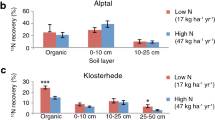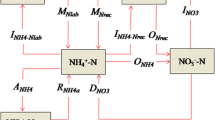Abstract
Dissolved organic nitrogen (DON) has recently been recognized as an important component of terrestrial N cycling, especially under N-limited conditions; however, the effect of increased atmospheric N deposition on DON production and loss from forest soils remains controversial. Here we report DON and dissolved organic carbon (DOC) losses from forest soils receiving very high long-term ambient atmospheric N deposition with or without additional experimental N inputs, to investigate DON biogeochemistry under N-saturated conditions. We studied an old-growth forest, a young pine forest, and a young mixed pine/broadleaf forest in subtropical southern China. All three forests have previously been shown to have high nitrate (NO −3 ) leaching losses, with the highest loss found in the old-growth forest. We hypothesized that DON leaching loss would be forest specific and that the strongest response to experimental N input would be in the N-saturated old-growth forest. Our results showed that under ambient deposition (35–50 kg N ha−1 y−1 as throughfall input), DON leaching below the major rooting zone in all three forests was high (6.5–16.9 kg N ha−1 y−1). DON leaching increased 35–162% following 2.5 years of experimental input of 50–150 kg N ha−1 y−1. The fertilizer-driven increase of DON leaching comprised 4–17% of the added N. A concurrent increase in DOC loss was observed only in the pine forest, even though DOC:DON ratios declined in all three forests. Our data showed that DON accounted for 23–38% of total dissolved N in leaching, highlighting that DON could be a significant pathway of N loss from forests moving toward N saturation. The most pronounced N treatment effect on DON fluxes was not found in the old-growth forest that had the highest DON loss under ambient conditions. DON leaching was highly correlated with NO −3 leaching in all three forests. We hypothesize that abiotic incorporation of excess NO −3 (through chemically reactive NO −2 ) into soil organic matter and the consequent production of N-enriched dissolved organic matter is a major mechanism for the consistent and large DON loss in the N-saturated subtropical forests of southern China.




Similar content being viewed by others
References
Aber JD, McDowell W, Nadelhoffer K, Magill A, Berntson G, Kamakea M, McNulty S, Currie W, Rustad L, Fernandez I. 1998. Nitrogen saturation in temperate forest ecosystems: hypotheses revisited. BioScience 48:921–34.
Berntson GM, Aber JD. 2000. Fast nitrate immobilization in N saturated temperate forest soils. Soil Biol Biochem 32:151–6.
Brookshire ENJ, Valett HM, Thomas SA, Webster JR. 2007. Atmospheric N deposition increases organic N loss from temperate forests. Ecosystems 10:252–62.
Colman BP, Fierer N, Schimel JP. 2007. Abiotic nitrate incorporation in soil, is it real? Biogeochemistry 84:161–9.
Dail BD, Davidson EA, Chorover J. 2001. Rapid abiotic transformation of nitrate in an acid forest soil. Biogeochemistry 54:131–46.
Davidson EA, Matson PA, Vitousek PM, Riley R, Dunkin K, Garcia-Mendez G, Maass JM. 1993. Processes regulating soil emissions of NO and N2O in a seasonally dry tropical forest. Ecology 74:130–9.
Davidson EA, Chorover J, Dail DB. 2003. A mechanism of abiotic immobilization of nitrate in forest ecosystems: the ferrous wheel hypothesis. Glob Chang Biol 9:228–36.
Fang YT, Zhu WX, Mo JM, Zhou GY, Gundersen P. 2006. Dynamics of soil inorganic nitrogen and their responses to nitrogen additions in three subtropical forests, south China. J Environ Sci (China) 18:752–9.
Fang YT, Gundersen P, Mo JM, Zhu WX. 2008. Input and output of dissolved organic and inorganic nitrogen in subtropical forests of South China under high air pollution. Biogeosciences 5:339–52.
Fenn MA, Poth MA, Aber JD, Baron JS, Bormann BT, Johnson DW, Lemly AD, McNulty SG Ryan DF, Stottlemyer R. 1998. Nitrogen excess in North American ecosystems: predisposing factors, ecosystem responses, and management strategies. Ecol Appl 8:706–33.
Findlay S. 2005. Increased carbon transport in the Hudson River: unexpected consequence of nitrogen deposition? Front Ecol Environ 3:133–7.
Fitzhugh RD, Lovett GM, Venterea RT. 2003. Biotic and abiotic immobilization of ammonium, nitrite, and nitrate in soils developed under different tree species in the Catskill Mountains, New York, USA. Glob Chang Biol 9:1591–601.
Goodale CL, Aber JD, McDowell WH. 2000. The long-term effects of disturbance on organic and inorganic nitrogen export in the White Mountains, New Hampshire. Ecosystems 3:433–50.
Gundersen P, Emmett BA, Kjønaas OJ, Koopmans C, Tietema A. 1998. Impact of nitrogen deposition on nitrogen cycling in forest: a synthesis of NITREX data. For Ecol Manage 101:37–55.
Gundersen P, Schmidt IK, Raulund-Rasmussen K. 2006. Leaching of nitrate from temperate forests—effects of air pollution and forest management. Environ Rev 14:1–57.
Gruber N, Galloway JN. 2008. An earth-system perspective of the global nitrogen cycle. Nature 451:293–6.
He JH, Chen ZQ, Liang YA. 1982. The soil of Ding Hu Shan. Trop Subtrop For Ecosyst 1:25–38.
Hedin LO, Armesto JJ, Johnson AH. 1995. Patterns of nutrient loss from unpolluted, old-growth temperate forests: evaluation of biogeochemical theory. Ecology 72:493–509.
Hedin LO, von Fischer JC, Ostrom NE, Kennedy BP, Brown MG, Robertson GP. 1998. Thermodynamic constraints on nitrogen transformations and other biological processes at soil-stream interactions. Ecology 79:684–703.
Hedin LO, Vitousek PM, Matson PA. 2003. Nutrient losses over four million years of tropical forest development. Ecology 84:2231–55.
Huang ZF, Fan ZG. 1982. The climate of Ding Hu Shan. Trop Subtrop For Ecosyst 1:11–23.
Huang ZL, Ding MM, Zhang ZP, Yi WM. 1994. The hydrological processes and nitrogen dynamics in a monsoon evergreen broad-leafed forest of Dinghu Shan. Acta Phytoecol Sin 18:194–9.
Liao LY, Ding MM, Zhang ZP, Yi WM, Guo GZ, Huang ZL. 1993. Root biomass and its nitrogen dynamic of some communities in Dinghushan. Acta Phytoecol Geobot Sin 17:56–60.
Liu GS, Jiang NH, Zhang LD, Eds. 1996. Soil physical and chemical analysis and description of soil profiles. Beijing: Standards Press of China.
Lohse KA, Matson P. 2005. Consequences of nitrogen additions for soil processes and solution losses from wet tropical forests. Ecol Appl 15:1629–48.
Lovett GM, Weathers KC, Sobczak WV. 2000. Nitrogen saturation and retention in forested watersheds of the Catskill Mountains, New York. Ecol Appl 10:73–84.
Magill A, Aber J, Berntson G, McDowell W, Nadelhoffer K, Melillo J, Steudler P. 2000. Long-term nitrogen additions and nitrogen saturation in two temperate forests. Ecosystems 3:238–53.
Magill AH, Aber JD, Currie SS, Nadelhoffer KJ, Martin ME, McDowell WH, Melillo JM, Steudler P. 2004. Ecosystem response to 15 years of chronic nitrogen additions at the Harvard Forest LTER, Massachusetts, USA. For Ecol Manage 196:7–28.
Martinelli LA, Piccolo MC, Townsend AR, Vitousek PM, Cuevas E, Mcdowell W, Robertson GP, Santos OC, Treseder K. 1999. Nitrogen stable isotopic composition of leaves and soil: tropical versus temperate forests. Biogeochemistry 46:45–65.
Matson PA, McDowell WH, Townsend AR, Vitousek PM. 1999. The globalization of N deposition: ecosystem consequences in tropical environments. Biogeochemistry 46:67–83.
McDowell WH, Magill AH, Aitkenhead-Peterson JA, Aber JD, Merriam J, Kaushal S. 2004. Effects of chronic nitrogen amendment on dissolved organic matter and inorganic nitrogen in soil solution. For Ecol Manage 196:29–41.
Michalzik B, Kalbitz K, Park JH, Solinger S, Matzner E. 2001. Fluxes and concentrations of dissolved organic carbon and nitrogen—a synthesis for temperate forests. Biogeochemistry 52:173–205.
Mo JM, Brown S, Peng SL, Kong GH. 2003. Nitrogen availability in disturbed, rehabilitated and mature forests of tropical China. For Ecol Manage 175:573–83.
Möller A, Kaiser K, Guggenberger G. 2005. Dissolved organic carbon and nitrogen in precipitation, throughfall, soil solution, and stream water of the tropical highlands in northern Thailand. J Plant Nutr Soil Sci 168:649–59.
Neff JC, Holland EA, Dentener FJ, Mcdowell WH, Russell KM. 2002. The origin, composition and rates of organic nitrogen deposition: a missing piece of the nitrogen cycle? Biogeochemistry 57/58:99–136.
Park JH, Matzner E. 2006. Detrial control on the release of dissolved organic nitrogen (DON) and dissolved inorganic (DIN) from the forest floor under chronic N deposition. Environ Pollut 143:178–85.
Pellerin BA, Kaushal SS, McDowell WH. 2006. Does anthropogenic nitrogen enrichment increase organic nitrogen concentrations in runoff from forested and human-dominated watersheds? Ecosystems 9:852–64.
Perakis SS, Hedin LO. 2002. Nitrogen loss from unpolluted South American forests mainly via dissolved organic compounds. Nature 415:416–9.
Pregitzer KS, Zak DR, Burton AJ, Ashby JA, MacDonald NW. 2004. Chronic nitrate additions dramatically increase the export of carbon and nitrogen from northern hardwood ecosystems. Biogeochemistry 68:179–97.
Qualls RG, Haines BL. 1992. Biodegradability of dissolved organic matter in forest throughfall, soil solution, and stream water. Soil Sci Soc Am J 56:578–86.
Raastad IA, Mulder J. 1999. Dissolved organic matter (DOM) in acid forest soils at Gårdsjön (Sweden): natural variabilities and effects of increased input of nitrogen and of reversal of acidification. Water Air Soil Pollut 114:199–219.
Rastetter EB, Perakis SS, Shaver GR, Ågren GI. 2005. Terrestrial C sequestration at elevated CO2 and temperature: the role of dissolved organic nitrogen loss. Ecol Appl 15:71–86.
Robertson GP, Groffman PM. 2007. Nitrogen transformations. In: Paul EA, Ed. Soil microbiology, ecology, and biochemistry. Amsterdam: Academic Press. pp 341–64.
Schimel JP, Bennett J. 2004. Nitrogen mineralization: challenges of a changing paradigm. Ecology 85:591–602.
Schwendenmann L, Veldkamp E. 2005. The role of dissolved organic carbon, dissolved organic nitrogen, and dissolved inorganic nitrogen in a tropical wet forest ecosystem. Ecosystems 8:339–51.
Sjöberg G, Bergkvist B, Berggren D, Nilsson SI. 2003. Long term N addition effects on the C mineralization and DOC production in mor humus under spruce. Soil Biol Biochem 35:1305–15.
Van Breemen N. 2002. Nitrogen cycle: natural organic tendency. Nature 415:381–2.
Vestgarden LS, Abrahamsen G, Stuanes AO. 2001. Soil solution response to nitrogen and magnesium application in a Scots pine forest. Soil Sci Soc Am J 65:1812–23.
Vitousek PM, Reiners WA. 1975. Ecosystem succession and nutrient retention-hypothesis. BioScience 25:376–81.
Vitousek PM, Sanford RL. 1986. Nutrient cycling in moist tropical forest. Annu Rev Ecol Syst 17:137–67.
Vitousek P, Aber J, Howarth R, Likens G, Matson P, Schindler D, Schlesinger W, Tilman D. 1997. Human alteration of the global nitrogen cycle: causes and consequences. Ecol Appl 7:737–50.
Vitousek PM, Hedin LO, Matson PA, Fownes JH, Neff J. 1998. Within-system element cycles, input-output budgets, and nutrient limitation. In: Pace ML, Groffman PM, Eds. Successes, limitations, and frontiers in ecosystem science. New York: Springer. pp 432–51.
Wang ZH, He D, Song S, Chen S, Chen D, Tu MZ. 1982. The vegetation of Ding Hu Shan biosphere reserve. Trop Subtrop For Ecosyst 1:77–141.
Wen DZ, Wei P, Kong GH, Ye WH. 1999. Production and turnover rate of fine roots in two lower subtropical forest sites at Dinghushan. Acta Phytoecol Sin 23:361–9.
Zhu WX, Carriero MM. 2004. Soluble organic nitrogen and microbial nitrogen dynamics in deciduous forest soils: neglected segments of the nitrogen cycle. Soil Biol Biochem 36:267–78.
Acknowledgments
This study was funded by the National Natural Science Foundation of China (No. 40703030; 30670392), Provincial Natural Science Foundation of Guangdong (No. 7006915), and Key Project of Chinese Academy of Sciences Knowledge Innovation Program (KZCX2-YW-432-2, KSCX2-SW-133). We are grateful to two anonymous reviewers for their critical and constructive comments and Dr. Curt Pueshel’s editorial assistance that greatly improved the quality of the manuscript. We also thank X.M. Fang, Y. Isogi, and others for assistance in the field and laboratory.
Author information
Authors and Affiliations
Corresponding author
Additional information
Dr. YT Fang performed research, analyzed data, and wrote the paper; Prof. WX Zhu participated in the initial experimental design, analyzed data, and took part in writing the paper; Prof. P Gundersen conceived the study and took part in writing; Prof. JM Mo and Prof. GY Zhou conceived study; Prof. M Yoh analyzed part of the data and contributed to the development of DON model.
Rights and permissions
About this article
Cite this article
Fang, Y., Zhu, W., Gundersen, P. et al. Large Loss of Dissolved Organic Nitrogen from Nitrogen-Saturated Forests in Subtropical China. Ecosystems 12, 33–45 (2009). https://doi.org/10.1007/s10021-008-9203-7
Received:
Revised:
Accepted:
Published:
Issue Date:
DOI: https://doi.org/10.1007/s10021-008-9203-7




